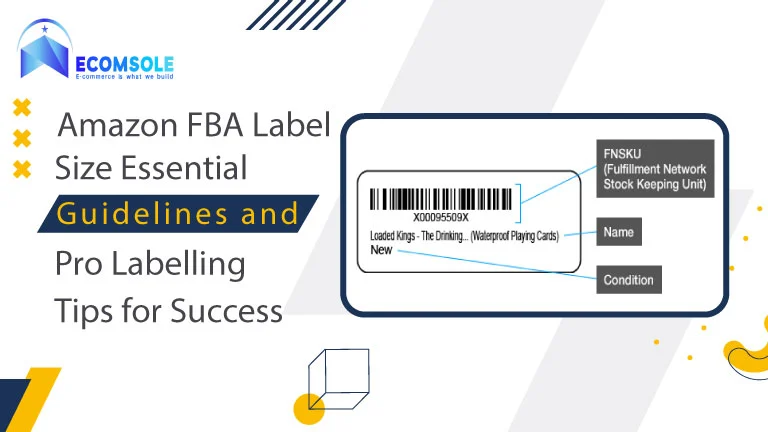Introduction
Ever wondered why some Amazon products shine while others fade into the background? The secret lies in the small yet crucial detail: the perfect FBA label size! Picture your label as your product’s friendly face, introducing it to the world. But, how do you guarantee that it’s precisely the way you want it? That’s where we come in!
Let’s start with the basics: “Amazon FBA Label Size.” What is it, and why does it matter? Think of it as your product’s unique ID, helping buyers find it effortlessly. Imagine this: a label too big might cover your product’s charm, while one too small might go unnoticed.
In our quick guide, we break down the rules into simple steps. No jargon, just clear advice you can use right away! Curious about the experts’ secret sauce? We’ve got you covered! With our tips, your products will not only look fantastic but also sell like hotcakes. So, are you ready to transform your Amazon game? Dive into our guide, and let’s make your products stand out together!
Understanding FBA Label Size
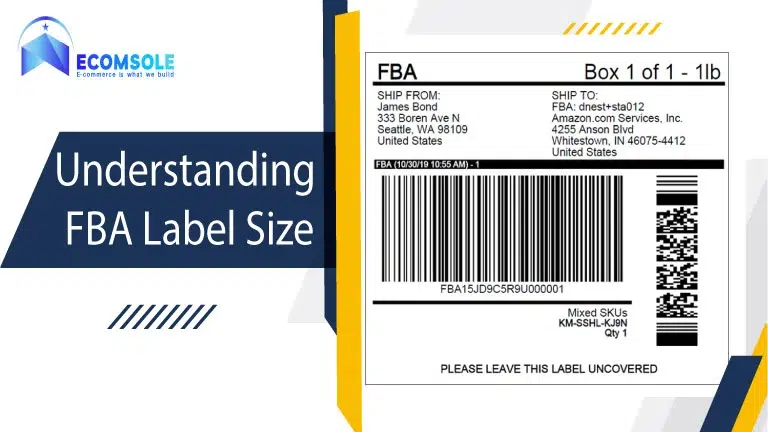
Knowing the right dimensions for Amazon FBA labels is crucial. Why? Because it affects your inventory management, shipping speed, and, ultimately, customer satisfaction. Let’s delve into this subject matter.
The standard size for each FBA label is 3 1/3 x 4 inches (8.4 x 10.2 cm). This dimension provides ample space for essential information, including the product’s ASIN and shipment ID. These labels are designed to be clear, concise, and easily readable by scanners, facilitating seamless inventory management.
For sellers equipped with thermal printers, there’s an alternative label size of 4 x 6 inches (10.2 x 15.2 cm). Utilizing this larger size is permissible if you have the specialized equipment. Thermal printers offer high-quality, smudge-free printing, ensuring the barcodes are sharp and scannable, which is crucial for efficient processing within Amazon’s fulfilment centres.
Regardless of the chosen size, maintaining a clear zone around the barcode is vital. Amazon recommends a quiet zone of at least 0.25 inches (6.35 mm) on all sides of the barcode. This space ensures accurate scanning and prevents any potential errors during the inventory tracking process.
Adhering to these specifications is not just a matter of compliance; it’s a strategic move for sellers. Accurate labeling expedites the intake process at Amazon’s facilities, reducing the likelihood of errors and ensuring that products are swiftly made available for purchase. By understanding and implementing the appropriate FBA label size, sellers can optimize their FBA experience, leading to enhanced customer satisfaction and improved operational efficiency in the competitive landscape of e-commerce.
Importance of Correct FBA Label Size
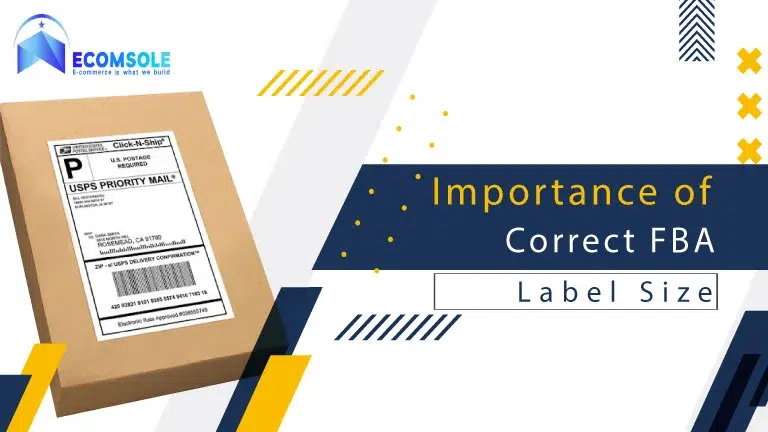
Maximize the potential of your product by understanding the crucial role that correct label size plays in its success. When it comes to brand representation, your label is the face of your product. It’s the first thing your customers see, and it should convey your brand’s identity, values, and quality. Using the right label size ensures that your brand message is communicated effectively, leaving a lasting impression.
In the world of following rules (like legal matters), different items require specific labels. It’s not merely about aesthetics; it’s about adhering to regulations. Using the correct FBA label size isn’t just about appearance; it’s about complying with laws that can lead to legal trouble if ignored. So, ensure your labels are the appropriate size for your product category. It’s not just about how it appears; it’s about doing things correctly.
Visual appeal is another critical aspect influenced by label size. Labels that are too large or too small can disrupt the overall harmony of your product’s packaging. The correct label size ensures that your product looks professional and visually appealing on the shelf, attracting potential customers.
Guidelines for FBA Label Size

Mastering the details of Amazon’s Fulfilment by Amazon (FBA) program is a game-changer for online sellers, and one paramount detail is the FBA label size. A correctly sized and clearly printed label is the unsung hero of efficient warehouse operations.
Why is this so crucial? A label that meets the ideal 1-inch by 2 5/8 inches dimension ensures products glide smoothly through Amazon’s vast fulfilment network, minimizing hiccups and maximizing customer satisfaction.
But why stop at size alone? Legibility, durability, and adherence to Amazon’s FBA labelling guidelines can make or break a seller’s reputation. A smudged or improperly sized label can lead to delays, misplaced items, or even lost sales. Thus, for those aiming for the coveted Amazon’s Choice or Best Seller tags, precision in labelling is not just an afterthought—it’s a strategic necessity.
Integrate high-traffic keywords such as “Amazon FBA label best practices”, “FBA label dimensions”, and “Amazon fulfilment labelling guidelines” into your product listings, blogs, or informational content. It not only enhances visibility in search engine results but positions you as a knowledgeable seller in the eyes of potential customers.
In the competitive world of e-commerce, where minute details can lead to significant differentiators, being armed with the right knowledge about FBA label sizes and requirements can propel your business to the forefront. Embrace accuracy, prioritize compliance, and witness your Amazon FBA venture thrive like never before. Dive deep, learn continuously, and stand out in the bustling Amazon marketplace.
Common Mistakes in FBA Labelling
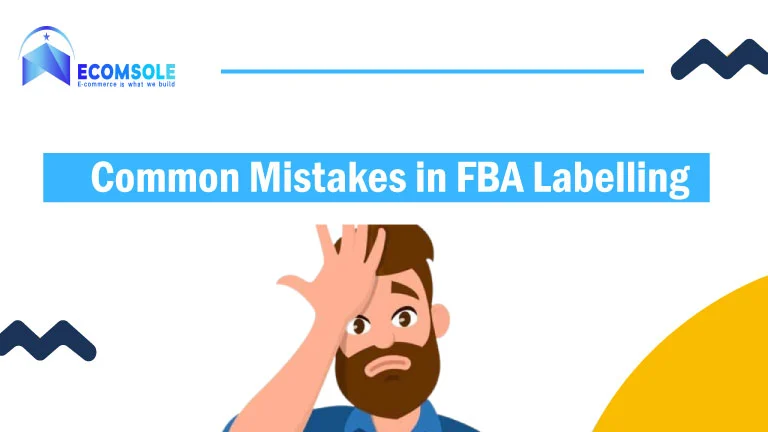
Amazon’s Fulfilment by Amazon (FBA) can be a goldmine for sellers. Still, its intricacies, especially in labelling, often trip up even seasoned merchants. The right approach to FBA label size isn’t just about compliance—it’s about ensuring your products move smoothly through Amazon’s vast fulfilment ecosystem, leading to quicker deliveries and consistent positive feedback.
Key Points to Remember
Precision in Dimensions: A frequent misstep is neglecting the recommended label dimensions. It can lead to scanning issues and processing delays.
High-Quality Printing: Labels should be crisp and clear. Blurred or low-resolution labels can hinder product identification, causing potential mix-ups.
Durability Matters: opt for smudge-proof and fade-resistant labels. A smudged barcode might mean your product languishes unprocessed.
Updated Information: Ensure labels reflect the most current product details. Outdated or incorrect information can confuse warehouse processes and lead to returns.
Positioning is Key: Place labels where they’re easily visible and accessible. Hidden or obstructed barcodes can result in processing snags.
Overcoming FBA Label Size Issues
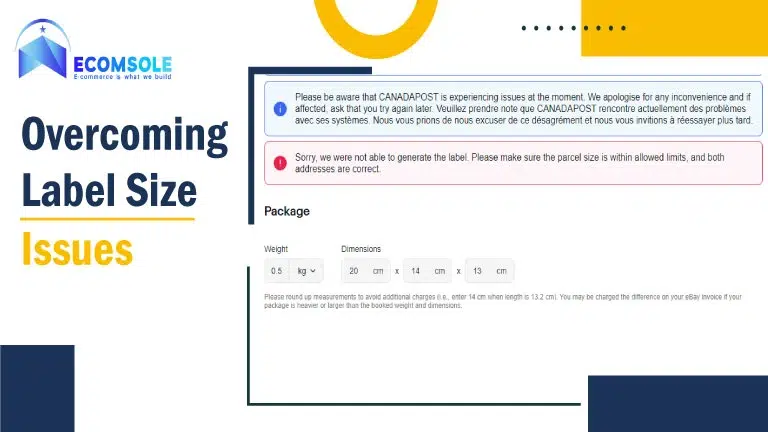
Labelling might seem like a small part of product packaging. Still, it’s a crucial component that can have significant implications, especially in systems like Amazon’s Fulfilment by Amazon (FBA). Ensuring the correct FBA label size is vital for efficient scanning, storage, and shipment of products.
Why Label Size Matters: Label size is more than just a requirement; it’s a critical factor in ensuring operational efficiency. Incorrect label size can cause:
Scanning Difficulties: Barcodes that aren’t of the correct size can be challenging to scan, leading to delays.
Processing Errors: Improperly sized labels may lead to mistakes in order identification or even mis-shipment of items.
Increased Costs: Incorrect labelling may lead to additional fees or costs associated with correcting errors.
Steps to Overcome Label Size Issues
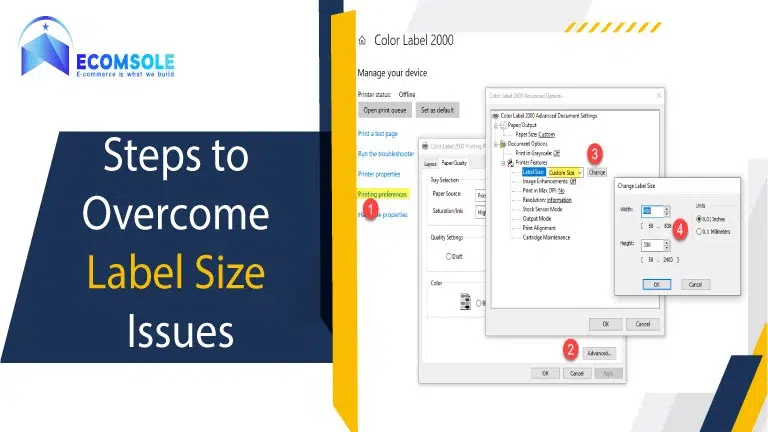
Know the Standards: Familiarize yourself with the requirements of the system you’re using. For instance, Amazon’s FBA program has specific label size guidelines.
Invest in Quality Printing: A quality printer that can produce clear, precise labels at the required dimensions is essential.
Use the Right Software: Labelling software can help ensure that you’re creating and printing labels of the correct size.
Regularly Review and Update: Always review your labelling practices and stay updated with any changes in guidelines or requirements.
Train and Educate Staff: Ensure that anyone involved in the labelling process is well-informed about the importance of correct label sizes and how to achieve them.
Benefits of Professional Labelling

When you’re selling something, how you present it and how accurate the information is can be just as important as the product itself. One key part of this presentation is labelling. If you label professionally and accurately, it can make your brand look better, make your work smoother, and make customers trust you more. Let’s dive into the many advantages of investing in professional labelling.
Enhanced Brand Image: A professionally designed and applied label resonates with quality and commitment. It communicates that a brand cares about even the smallest details, thus enhancing its image in the eyes of consumers.
Improved Accuracy: Professional labelling systems ensure that each label is accurate, reducing the potential for costly mistakes, Mis-shipments, or customer dissatisfaction arising from labelling errors.
Operational Efficiency: In systems like warehousing, logistics, or retail, barcoded or RFID labels that adhere to industry standards can significantly expedite processes like inventory management, tracking, and billing.
Durability and Consistency: Professional labels are typically designed to withstand various environmental factors such as heat, moisture, or friction. It ensures that labels remain readable and intact throughout a product’s lifecycle, from storage to the customer’s hands.
Regulatory Compliance: Certain industries have strict labelling regulations to ensure consumer safety and inform purchasing decisions. Professional labelling guarantees adherence to these standards, minimizing legal risks.
Enhanced Customer Experience: Accurate, clear, and informative labels enable customers to make informed decisions quickly. Whether it’s about ingredients, usage instructions, or safety precautions, a well-labelled product simplifies the buyer’s journey.
Eco-friendly Options: With the growing emphasis on sustainability, professional labelling now often incorporates eco-friendly materials and processes. It will not only minimize environmental impact but can also resonate with eco-conscious consumers.
Versatility in Design: Modern labelling technologies offer a vast range of design options, allowing brands to integrate holography, variable data printing, or even augmented reality into their labels, enhancing consumer engagement.
How FBA Label Size Affects Product Rankings?
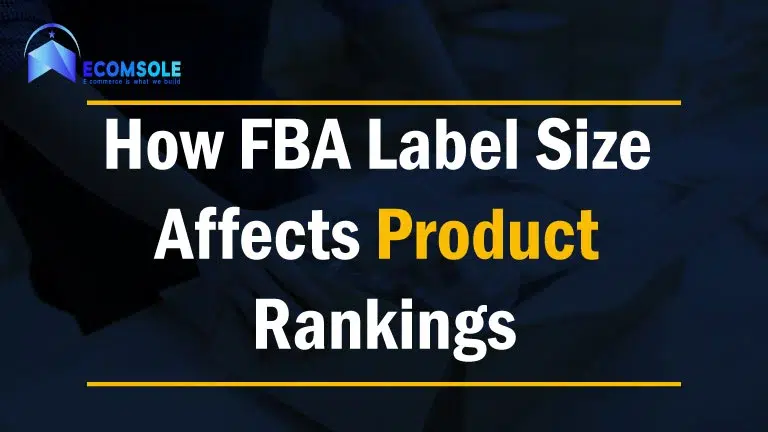
When it comes to selling products online, particularly through platforms like Amazon, the size of your FBA (Fulfillment by Amazon) label plays a crucial role in determining your product’s ranking. The FBA label size influences how your product is displayed, making it more visible to potential customers.
Amazon uses complex algorithms to rank products based on various factors, and one of them is the accuracy and visibility of product labels. Properly sized FBA labels ensure that your product is correctly categorized and easily searchable, enhancing its chances of ranking higher in search results.
Adequate label size not only ensures compliance with Amazon’s guidelines but also impacts customer experience. Clear, readable labels make it easier for customers to identify your product, leading to increased trust and potential sales. Therefore, investing in the right FBA label size can significantly impact your product’s visibility, credibility, and overall sales performance on online platforms.
Tips for First-Time FBA Sellers
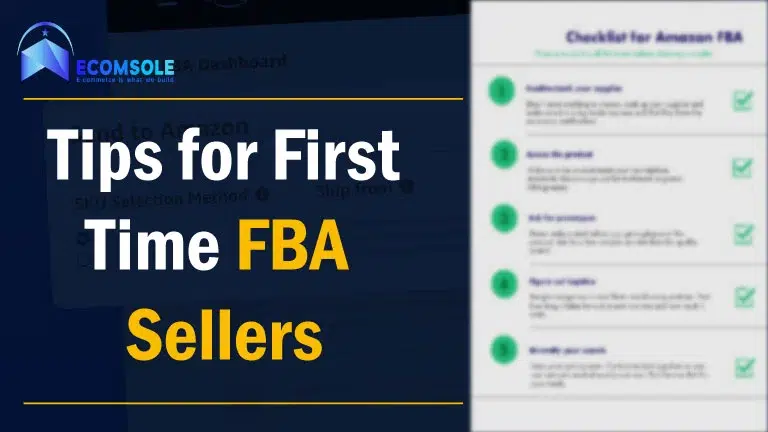
Breaking into the Amazon FBA (Fulfilment by Amazon) marketplace can be both exciting and daunting. As you embark on this journey, here are some essential tips to help you navigate the platform effectively:
Research Products Thoroughly: Before diving in, spend ample time researching to identify profitable and in-demand products. Utilize tools like Jungle Scout or Helium 10 for market insights.
Understand Amazon’s Fees: Familiarize yourself with Amazon’s fee structure, including referral fees, storage fees, and FBA fees, to ensure profitability.
Prioritize Product Listings: A product’s title, images, and description play a crucial role in attracting customers. Invest in high-quality photos and craft compelling, keyword-rich descriptions.
Optimize for SEO: Amazon’s algorithm, known as A9, determines product rankings. Learn the basics of Amazon SEO to enhance your product’s visibility.
Manage Inventory Wisely: Avoid stocking too much Inventory initially. Track sales patterns over time and adjust inventory levels accordingly to avoid long-term storage fees.
Master Labelling and Packaging: Comply with Amazon’s strict labelling and packaging guidelines. Consider using FBA-approved label software and ensure your products are packaged securely to avoid damage during transit.
Gather Reviews: Customer reviews greatly influence buying decisions. Consider using Amazon’s Early Reviewer Program or request feedback post-purchase to build credibility.
Stay Updated with Policies: Amazon’s policies and guidelines evolve. Regularly check for updates to remain compliant and avoid potential pitfalls.
Consider Brand Registry: If you have a trademarked brand, consider enrolling in Amazon Brand Registry. It provides increased control over product listings and offers protection against counterfeiters.
Engage with the Community: Join FBA seller forums or Facebook groups. These communities can be invaluable sources of advice, updates, and shared experiences.
Starting as an FBA seller requires patience, persistence, and continuous learning. By keeping these tips in mind and being adaptable, you’ll be better positioned for success in the expansive Amazon marketplace.
Conclusion
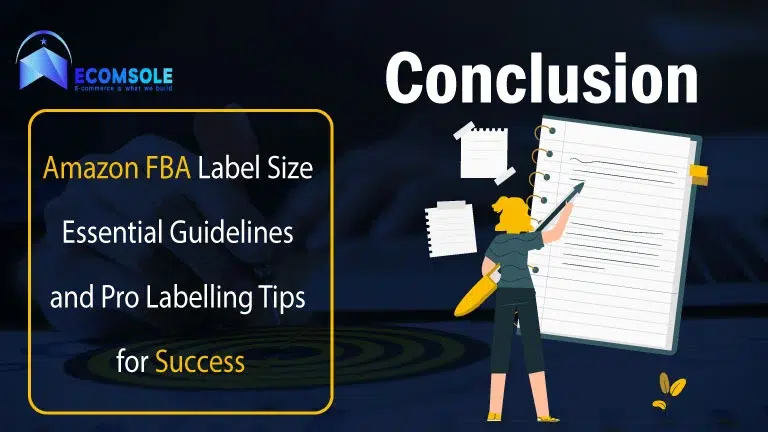
Navigating the complex world of Amazon’s FBA platform demands careful attention to the little things, and one of the most crucial details is the FBA Label Size you use. As we’ve explained in this article, the dimensions of your FBA labels aren’t just technical specifications. They are fundamental elements that enhance how smoothly your operations run and how satisfied your customers are.
Using the right-sized labels makes processing products easier, reduces mistakes, and ensures timely deliveries. All of this directly impacts how people view your brand and how much they trust it in the marketplace. We appreciate you delving into this topic with us. Armed with these insights, you’re better prepared to make the most of the Amazon FBA platform, giving your business the potential for long-term growth and success.
FAQs
Amazon FBA Label Size Essential Guidelines and Pro Labelling Tips for Success



